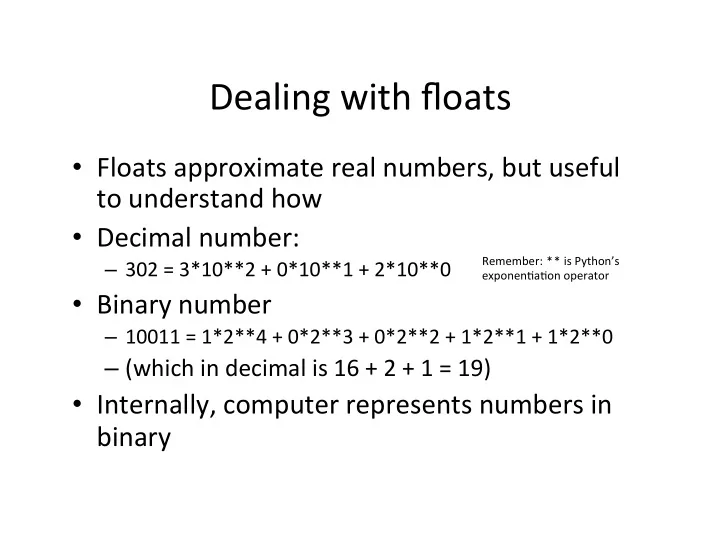

Dealing ¡with ¡floats ¡ • Floats ¡approximate ¡real ¡numbers, ¡but ¡useful ¡ to ¡understand ¡how ¡ • Decimal ¡number: ¡ Remember: ¡ ** ¡is ¡Python’s ¡ – 302 ¡= ¡3*10**2 ¡+ ¡0*10**1 ¡+ ¡2*10**0 ¡ exponenMaMon ¡operator ¡ • Binary ¡number ¡ – 10011 ¡= ¡1*2**4 ¡+ ¡0*2**3 ¡+ ¡0*2**2 ¡+ ¡1*2**1 ¡+ ¡1*2**0 ¡ – (which ¡in ¡decimal ¡is ¡16 ¡+ ¡2 ¡+ ¡1 ¡= ¡19) ¡ ¡ • Internally, ¡computer ¡represents ¡numbers ¡in ¡ binary ¡ ¡
ConverMng ¡decimal ¡integer ¡to ¡binary ¡ ¡ • Consider ¡example ¡of ¡ – x ¡= ¡1*2**4 ¡+ ¡0*2**3 ¡+ ¡0*2**2 ¡+ ¡1*2**1 ¡+ ¡1*2**0 ¡ • If ¡we ¡take ¡remainder ¡relaMve ¡to ¡2 ¡ (x%2) of ¡this ¡ number, ¡that ¡gives ¡us ¡the ¡last ¡binary ¡bit ¡ • If ¡we ¡then ¡divide ¡x ¡by ¡2 ¡ (x/2) , ¡all ¡the ¡bits ¡get ¡ shiQed ¡leQ ¡ – ¡x/2 ¡= ¡1*2**3 ¡+ ¡0*2**2 ¡+ ¡0*2**1 ¡+ ¡1*2**0 ¡= ¡1001 ¡ • Keep ¡doing ¡successive ¡divisions; ¡now ¡remainder ¡ gets ¡next ¡bit, ¡and ¡so ¡on ¡ • Let’s ¡convert ¡to ¡binary ¡form ¡
Doing ¡this ¡in ¡Python ¡ if num < 0: � isNeg = True � num = abs(num) � else: � isNeg = False � result = ‘‘ � if num == 0: � result = ‘0’ � while num > 2: � result = str(num%2) + result � num = num/2 � if isNeg: � result = ‘-’ + result �
So ¡what ¡about ¡fracMons? ¡ • 3/8 ¡= ¡0.375 ¡= ¡3*10**(-‑1) ¡+ ¡7*10**(-‑2) ¡+ ¡5*10**(-‑3) ¡ • So ¡if ¡we ¡mulMply ¡by ¡a ¡power ¡of ¡2 ¡big ¡enough ¡ to ¡convert ¡into ¡a ¡whole ¡number, ¡can ¡then ¡ convert ¡to ¡binary, ¡then ¡divide ¡by ¡the ¡same ¡ power ¡of ¡2 ¡ • 0.375 ¡* ¡(2**3) ¡= ¡3 ¡(decimal) ¡ • Convert ¡3 ¡to ¡binary ¡(now ¡11) ¡ • Divide ¡by ¡2**3 ¡(shiQ ¡leQ) ¡to ¡get ¡0.011 ¡(binary) ¡
x = float(raw_input('Enter a decimal number between 0 and 1: ')) � � p = 0 � while ((2**p)*x)%1 != 0: � print('Remainder = ' + str((2**p)*x - int((2**p)*x))) � p += 1 � � num = int(x*(2**p)) � � result = '' � if num == 0: � result = '0' � while num > 0: � result = str(num%2) + result � num = num/2 � � for i in range(p - len(result)): � result = '0' + result � � result = result[0:-p] + '.' + result[-p:] � print('The binary representation of the decimal ' + str(x) + ' is ' + str(result)) � �
Some ¡implicaMons ¡ • If ¡there ¡is ¡no ¡integer ¡p ¡such ¡that ¡x*(2**p) ¡is ¡a ¡ whole ¡number, ¡then ¡internal ¡representaMon ¡is ¡ always ¡an ¡approximaMon ¡ • Suggest ¡that ¡tesMng ¡equality ¡of ¡floats ¡is ¡not ¡ exact ¡ – Use ¡abs(x-‑y) ¡< ¡0.0001, ¡rather ¡than ¡x ¡== ¡y ¡ • Why ¡does ¡print(0.1) ¡return ¡0.1, ¡if ¡not ¡exact? ¡ – Because ¡Python ¡designers ¡set ¡it ¡up ¡this ¡way ¡to ¡ automaMcally ¡round ¡
Recommend
More recommend